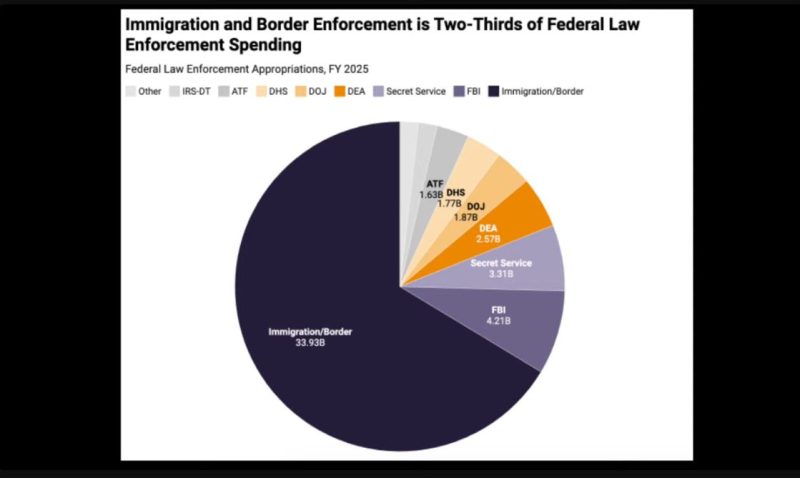Two Thirds of Federal Law Enforcement Budget Will Be Going To Immigration and Border
The United States has just taken a seismic leap in how it polices its borders and the people within them. With the passage of President Trump’s 170 billion “Big Beautiful Bill,” Immigration and Customs Enforcement, or ICE, is set to become the largest law enforcement agency in the world. ICE will now be bigger than the FBI, DEA, and even most national militaries. This is not just a budget story. It is a story about power, priorities, and the lived reality for millions of immigrants and their families.

The Numbers: ICE’s Unprecedented Expansion
Let’s start with the raw figures, because they are staggering. The bill allocates nearly 30 billion to ICE through 2029, with 45 billion earmarked for new detention centers. That is an increase of over 300 percent from last year’s budget. The agency will hire ten thousand new officers, build and expand detention facilities, and pour billions into border security technology and infrastructure. For context, ICE’s new budget dwarfs the combined budgets of the FBI, DEA, ATF, and U.S. Marshals. It even surpasses the military budgets of most countries around the globe.
What’s in the Bill: Beyond the Headlines
This is not just about more agents and bigger jails. The bill is a sweeping overhaul of how the U.S. approaches immigration.
Detention and Deportation
ICE will have the resources to detain more people than ever before, including families and children. Private prison companies are already expanding to meet the demand, with new facilities popping up in Virginia and California. The bill also funds a controversial new detention camp in the Florida Everglades, which critics have dubbed “Alligator Alcatraz.” This site has become a flashpoint for activists and immigrant advocates.
Border Security and Militarization
The Department of Defense gets one billion to deploy troops for border operations, and 46.6 billion is set aside for border wall construction and repairs. That is triple what was spent during Trump’s first term. There is also a new military buffer zone along the southern border, where migrants can be detained by active-duty troops until Border Patrol arrives. Legal experts are already raising alarms about potential violations of the Posse Comitatus Act, which restricts military involvement in domestic law enforcement.
Legal Pathways and Fees
The bill makes it harder and more expensive for immigrants to pursue legal status. Asylum seekers now face a one hundred dollar application fee, with no waivers except for unaccompanied minors. Work permit fees are up, and even children applying for special immigrant visas will have to pay. The child tax credit is now off-limits to U.S. citizen children of undocumented parents, and food assistance is further restricted.
The Human Impact: Fear, Uncertainty, and Resistance
The numbers and policies only tell part of the story. On the ground, the effects are immediate and deeply personal. In Los Angeles, public transit ridership has dropped as immigrants avoid leaving their homes. Schools report higher absenteeism among children in immigrant families. Restaurants in New York City see a spike in takeout orders as families avoid public spaces. The chilling effect is real, and it is spreading.
Anecdotes from community organizers paint a picture of neighborhoods on edge. One teacher in Houston described a classroom half-empty after a weekend of ICE raids. In Chicago, a local grocer said he has started delivering groceries to longtime customers who are too afraid to shop in person. These are not isolated incidents. They are the new normal in cities across the country.
The Politics: Why Now?
This bill is the centerpiece of Trump’s 2024 campaign promise: mass deportations and a “return to law and order.” The political calculus is clear. For the administration and its supporters, this is about deterrence, control, and a show of strength. For critics, it is a dangerous escalation, a “war on immigrants” that does little to address the root causes of migration or the realities of a complex, interconnected world.
The bill passed the House by a razor-thin margin, with Vice President JD Vance casting the tie-breaking vote in the Senate. The debate was fierce, with Democrats warning of the social and economic costs, and Republicans touting the bill as a necessary step to “restore American sovereignty.”
What Comes Next: Unanswered Questions
With ICE now the largest law enforcement agency in the world, the U.S. is entering uncharted territory. Will this massive investment actually reduce unauthorized immigration, or will it simply drive people further into the shadows? What happens to the millions of mixed-status families now facing new barriers to basic services? And how will communities respond as the machinery of enforcement grows ever larger and more visible?
One thing is certain. The conversation about immigration, enforcement, and what kind of country the U.S. wants to be is far from over. The stakes have never been higher.
